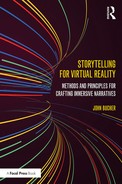Foreword
I am a child of the theme-park world. I grew up in central Florida right around the time Disney World opened. I remember going on the Haunted Mansion ride, and though I couldn’t have articulated it at the time, I recognized that when you move people through space while telling them a story, it creates the feeling of traveling on a journey and gives the experience meaning. I was lucky enough to find ways later in life to apply my love of spatial storytelling to the world of technology. I’ve always innately lived in that world, but this story’s not about me, it’s about how the recent rise of immersive media will affect our future.
We can reflect on every medium that has been created to tell stories and see that people eventually settle on certain elements that they like, and those elements then become the mainstream definition of what that medium is. Novels, movies, video games, plays, and television shows all have mainstream definitions based on the elements of those mediums that have been successful and lasted. As a medium continues to grow and explore new territory, you have departures and divergent paths off the original idea and methods of that medium. The cinematic language of VR is still developing. But it will only move forward and become more advanced through experimentation and by increasing the volume of stories being told in its space.
Many people have referred to VR as a new medium, or at least a new way to tell stories. I would be a contrarian to that idea. I would say that there is nothing fundamentally new about Virtual Reality. It’s a new way to experience what I refer to as spatially oriented entertainment—much like that Haunted Mansion ride I rode as a kid. The world of theme parks has been doing this for number of generations now. The world of theater has been doing it even longer. We have plenty to learn from these disciplines and plenty others.
In the world of flat-screen media, a movie theater can be anywhere you want it to be, including on an airplane or in your hands. The one element that doesn’t translate well in those environments is the idea of true spatial sense. With spatial storytelling, you get to move around, walk around, and activate. The best and most intriguing attempts to do this thus far, using flat-screen media, have been in the gaming world, where you use certain mechanics to give the impression that you’re moving in space, but your body, mind, and brain know that you’re looking at a flat screen. We have developed 3D technology, which gives us a pseudo-illusion that there’s depth, but depth is different than space. Virtual Reality is more than just adding depth to entertainment, it’s adding actual spatial universes.
As someone who focuses on the future for a major movie studio, I reflect into the past to see where the guiding lines and the divining rods are that give us telltale signs to what is ahead. For years now, we’ve stared into screens. We’re fooling our brain. We’re fooling our eyes into believing that what we are seeing on the screen is real. But what if we start to wear the screen? We can unbind the restrictions of the display. The creative starts to say, “What could I do if I didn’t have to work within the restrictions of a rectangular screen? What if you could literally strap a theme park to your face?” Once we cracked the code of the rectangle, the technology afforded the opportunity to build story all around us. Now we are finding different and unique ways to do this and finding the boundaries that we thought we used to have no longer exist.
We’re on a journey, but the promise of something better is here. We’ve started to crack the code, and now there are technologists, scientists, and storytellers working to see where this medium could take us as human beings. We’ll look back on these first waves of VR and one day chuckle, like we look back at our first laptops and our very first cell phones. The best storytellers I’ve seen thus far in Virtual Reality are the ones that understand how to explore the imagination in such a way that they don’t feel restricted anymore by the tools that they used to have.
The nature of storytelling will always remain the same. It’s now about how intense of an experience you can create for your participant. These new tools allow a new level of intensity, and the best storytellers will find ways to tap into that intensity that we haven’t really even seen yet. I don’t think we’ve seen the best of storytelling in VR at this point. I think that it’s going to come from a generation that starts to embrace this technology in different ways than we presently do because of our tendency to lean back into the past. We’re on the cusp of something that will be more powerful than perhaps any medium we’ve experienced before. I can’t wait to see what the future holds and the tales that storytellers will create as a result.
Ted Schilowitz
Futurist
20th Century Fox
Hollywood, CA
2016
